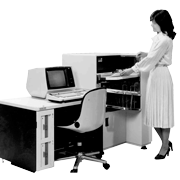Announced in August 1980, the FACOM 6315A was an OCR with intelligent terminal functions [Note 1] for distributed processing.
At the time, applications for information processing systems were expanding as corporations aimed greater efficiencies in business operations. Demands were growing for distributed network processing in which terminals connected to a corporate network carried out certain data processes. In particular, corporations sought devices that could “clean” data [Note 2] in the locations where data for information processing systems were generated. The FACOM 6315A was an OCR designed for distributed processing in order to meet these demands.
The FACOM 6315A aimed to provide higher recognition accuracy and faster processing speeds as well as greater application scope. This was made possible by faster hardware and the following technological advances.
- To improve recognition accuracy, the reader used a new outline scanning recognition method [Note 3] that focused on the shape of character outlines when reading characters.
- The 6315A could read more readable character types with its omnifont reading, which could read mixtures of four types of handwritten characters (letters, numbers, symbols, and kana characters) and mixtures of different fonts.
- To cut drastically the time required to clean data, the reader could parallel process a set of jobs. For example, it could parallel process a read job and a batch correction job or parallel process a read correction job and a data transfer / conversion utility job.
- Fujitsu used a charge coupled device (CCD) as the optical image sensor for the first time. The CCD made it easy to expand the scanning width, enabling the 6315A to read larger sheets such as B4 landscape and LP paper. (LP paper was a type of continuous form paper for line printers with a width of 15 inches.)
- Limitations on readable forms were reduced with a technology that read forms without reference marks [Note 4]. This expanded the range of operations the 6315A could be used for and lowered operating costs.
Note 1: Terminals with computing capabilities that were nodes forming a network centered on a host computer were called intelligent terminals.
Note 2: Cleaning data is the process of creating data from the input data with sufficient reliability and in a format that the mainframe or other host computer can use immediately without any preprocessing. Cleaning data includes removing any obvious input errors, recognizing handwritten characters, and converting them to character codes.
Note 3: Outline scanning was a character recognition technology that expanded on the earlier reflection method (see the FACOM 6312B). The method extracts characteristics of a written character’s outline and recognizes the character by identifying the character’s distinctive pattern. See the FACOM 6678A/B and FACOM 6679A pages for a description of Fujitsu’s handwritten kanji character recognition technology.
Note 4: The technology to find the center of a line without a reference mark included technologies to improve the scanner’s paper feed precision (to reduce elongations, contractions, and skewing), to detect the form’s position and slant, and to correctly align the line being read. A reference mark was a black mark added at one end or both ends of a form to enable the reader to detect accurately the position of characters on the form.


